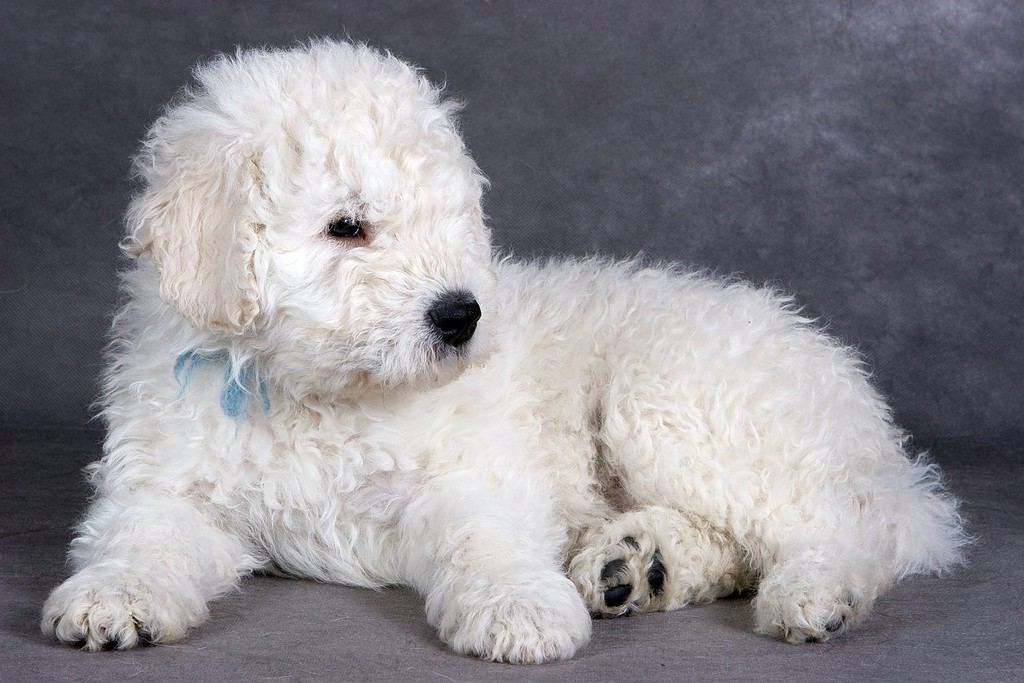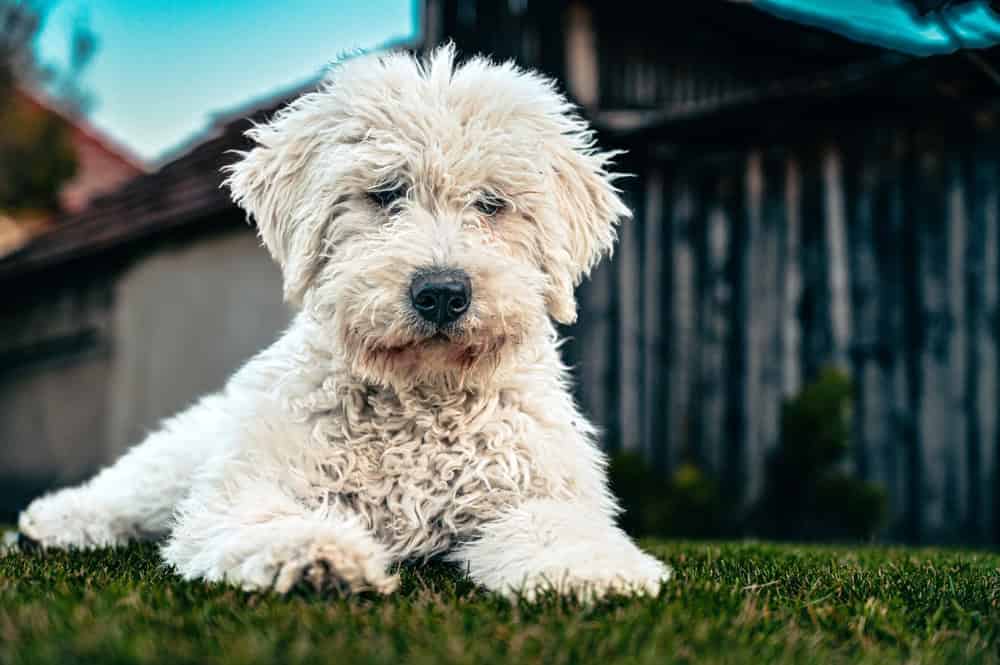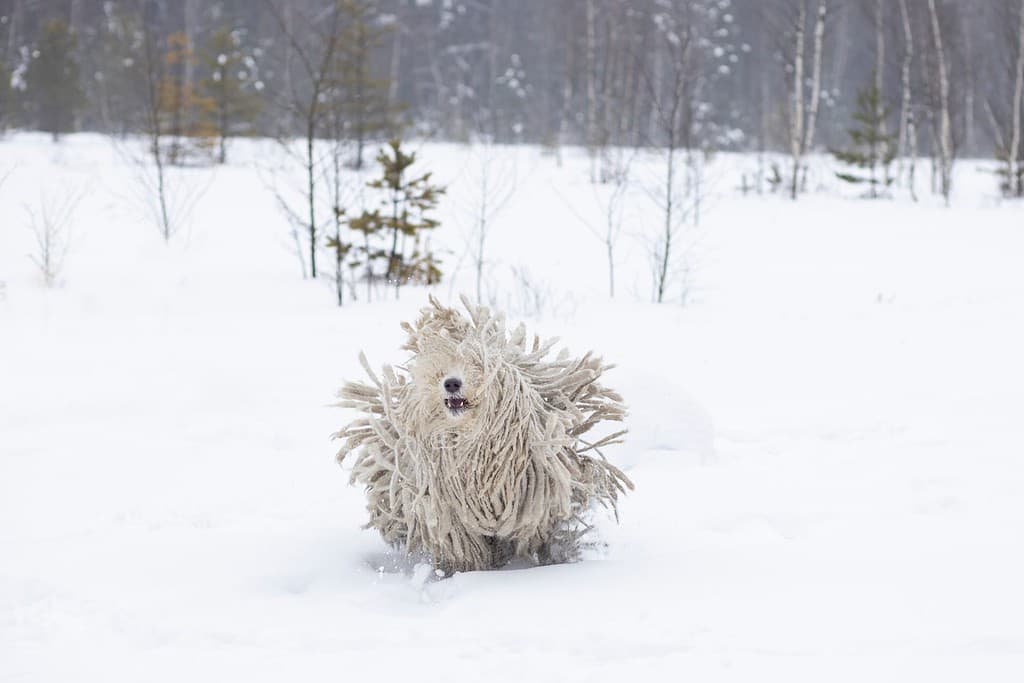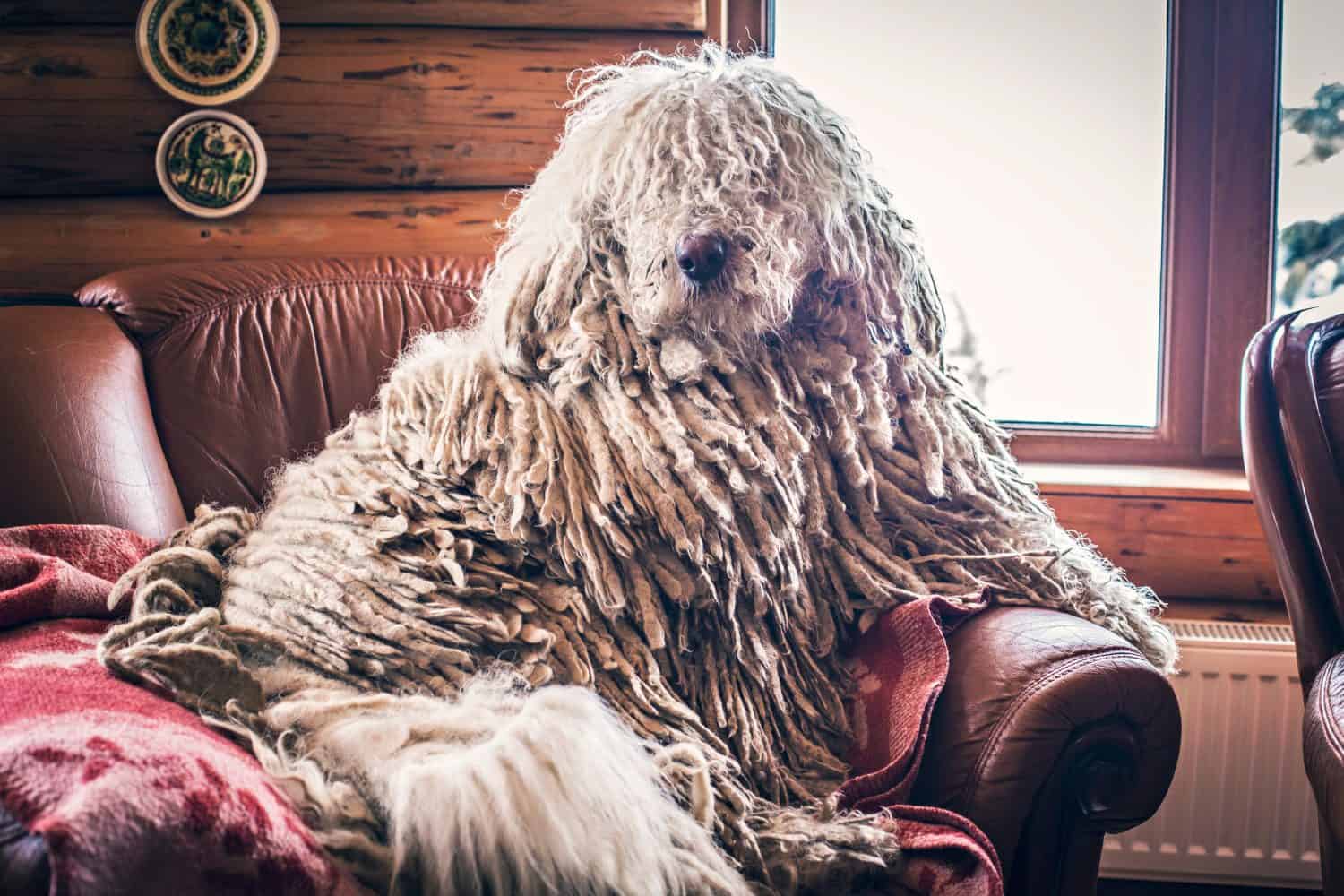The Komondor is a breed that everyone can’t take their eyes off. Their unique appearance makes them the talking point in any situation. Yet, there is a lot more to this dog than humorous comparisons with a mop! They are an accomplished working dog with loads to offer as a family pet. You should not take on a Komondor without carefully considering what it entails. Their coat alone is a big responsibility! It is always wise to talk things over with an experienced breeder so you know exactly what to expect. To get you started, we have put together a growth chart and some progression tips for this very special breed. You can use it to get a rough idea about Komondor pup progression along with some milestones and training tips.
Breed Summary
This breed is essentially a Hungarian flock dog. They were bred to guard sheep as they grazed. This means that they needed to be brave enough to fend off wolves and fit enough to withstand the rugged terrain. You may fall in love with their mop-like coat, but this is actually there for an important reason. It protected the dogs from the extreme weather conditions and from the sharp teeth and claws of predators. As an added bonus, the Komondor’s sheep-like appearance allowed them to blend in with the flock and surprise the predators at the last moment!
The stand-out feature of the Komondor is without doubt their striking coat. Its corded appearance is highly unusual and will need some special care. It is important that you consult an experienced breeder to learn how to look after it properly. The coat does not need to be brushed, but it does need to be washed regularly. The characteristic cords do not appear until the pup is around 9 or 10 months of age. Then, you will need to split the clumps into the dreadlocks so that they grow correctly.
Even though they are large dogs, they are surprisingly agile and light-footed. When it comes to personality, they are an independent dog who requires firm but fair handling. It is very important that pups are socialized from an early age. These dogs are used to working alone and are independent thinkers. They need to learn that you call the shots.
Komondor Growth and Weight Chart by Age
Because the Komondor is a large breed, it is important that your puppy does not put on too much weight too quickly. Puppies who have uncontrolled growth can suffer from joint problems later in life. Your breeder will be able to tell you how heavy the pup should be at different ages. This is because growth rates are partially dictated by genetics.
Your pup is likely to follow the same pattern as its Mom and Dad. There are other factors that control pup growth rates, including health, gender, litter, size, diet, and environment. It is very important that you keep in contact with your vet as your puppy is growing. Take the pup for regular, check-ups and weigh-ins. Your vet will be able to advise you on whether the puppy is gaining weight as they should. To give you a very rough idea of what to expect, here is a growth chart for Komondor puppies.
| Age | Male Weight | Female Weight |
| Birth | 3-5 lbs | 2-4 lbs |
| 1 Month | 10-15 lbs | 7 -9 lbs |
| 6 Weeks | 15-20 lbs | 13-18 lbs |
| 2 Months | 20-25 lbs | 18-22 lbs |
| 3 Months | 30-38 lbs | 28-35 lbs |
| 4 Months | 40-48 lbs | 38-48 lbs |
| 5 Months | 49-59 lbs | 48-58 lbs |
| 6 Months | 58-68 lbs | 52-66 lbs |
| 7 Months | 62-78 lbs | 60-75 lbs |
| 8 Months | 68-83 lbs | 62-82 lbs |
| 9 Months | 72-90 lbs | 66-85 lbs |
| 10 Months | 75-95 lbs | 70-92 lbs |
| 11 Months | 78-97 lbs | 72-95 lbs |
| 12 Months | 82-100 lbs | 75-96 lbs |
| 2 Years | 95-108 lbs | 77-98 lbs |
When Will My Komondor Stop Growing?
Komondors are a large breed dog and therefore do not stop growing until they are around two years old. They have a life expectancy of 12 years or more. Komondor puppies are extremely fluffy but do not have dreadlocks. This develops after nine months of age. While your puppy is growing, it is important to get the food balance, correct so they do not put on weight too rapidly.
How Big Will My Komondor Be When It’s Fully Grown?
The breed standard for Komondors requires them to have a large head, medium-sized and almond-shaped eyes, and erect ears in an elongated triangular shape. Males should stand at 27.5 inches to the withers and weigh around 100 pounds. Females should stand at 25.5 inches to the withers and weigh around 80 pounds. The exact size that your pup reaches is a combination of genetics and environmental factors.
When Should My Komondor Be Spayed or Neutered?
You may come across conflicting advice on the best age to spay or neuter your Komondor. Early neutering obviously prevents unwanted pups and there may be some health advantages. However, for larger breeds such as the Komondor, the advice is often to wait a little longer. The current advice from the American Kennel Club is that it may be best to wait until the age of 12-18 months to spay or neuter larger dog breeds such as the Komondor. This is because sex hormones may play a protective role in preventing some joint problems and cancers in larger breeds. However, it is important to stress that professional judgment is vital in these situations and so you should always consult a vet for their advice.
When Should My Komondor Be House Broken?
According to the Middle Atlantic States Komondor Club (MASKC), most Komondors are fairly easy to housetrain but there are always exceptions! They are clean dogs in the house and would prefer to go potty elsewhere. That said, MASKC states that a crate is very useful for housetraining this breed. Pups would prefer not to poop or wee in their crate and this encourages them to go potty outside.
Consistency and patience are both very important when house-training a puppy. You need to take them outside regularly and always after a nap and after meals. Praise them when they poop or pee in the right place and ignore it when they have ‘accidents’.
When Should My Komondor Stop Eating Puppy Food
When you pick up your Komondor puppy, the breeder will give you a small amount of the food that they have been weaned on. You should continue giving them this food until they settle in. Then, you can transition them onto another brand if you wish. It is important that you get a puppy food that is suitable for large-breed puppies to prevent excessive weight gain. The food packet contains information on when you should transition puppies onto adult food. This is often at around one years of age but your vet will be able to give you more specific information for your dog. Any changes in diet should be done gradually to prevent stomach upsets.
When Will My Komondor Start Losing Teeth?
You can expect your komondor puppy to start losing teeth at around four months of age, but it could be a bit later. Most puppies have all of their adult teeth by the time they are around six months of age. Dental hygiene is extremely important in dogs as dental disease can lead to other health issues. Get your new puppy used to having their teeth cleaned with a special toothbrush and a special dog toothpaste. If you do this from a young age, they will tolerate it much better as adults.
When Should I Start Training My Komondor?
It is very important that your Komondor is properly trained. They are large dogs and you do not want a dog of this size out of control! Experts recommend that you start obedience training at around four or five months of age. At this age, pups, learn readily and are happy to view training sessions as fun. As puppy adolescents, they can regress. Pups who happily did what they were told may suddenly decide that they can make decisions for themselves and that they do not have to listen to you. It is important that you are calm and consistent during this stage, they will soon turn into well-balanced adult dogs.
Socialization is crucial with this breed because they are guard dogs after all! If you don’t teach them that other human beings are friends, they may try to ‘protect’ you from visitors to your home.
What Cues Should I Teach My Komondor First?
Most people start with simple commands such as ‘sit’ and ‘stay’. As the Komondor is such a large dog, it is also important that you teach them to walk nicely by your side. Training sessions with young pups should be kept short so that they do not get bored. Always end on a positive note and have plenty of tasty treats with you as a reward.
When Will My Komondor Calm Down?
According to the Komondor Club of America, this breed is a large territorial dog who will make up their own mind about whether they want to welcome somebody onto your property or not. This is a trait that they are unlikely to ever grow out of. However, you can overcome it by socializing your puppy properly from a young age. They are also fairly vocal dogs and will get your attention with a very loud bark! This is also something that they are unlikely to grow out of. Most Komondors mature and become less playful and energetic after three years of age.
Common Health Issues Your Komondor Might Experience
Komondors are generally healthy dogs, although they can suffer from the usual canine infections and dental problems. There is some hip dysplasia associated with the breed but responsible breeders will have had their stock certified as being free of dysplasia. There are some other conditions that are common to large breeds that you should be aware of. These include bloat or gastric torsion. This is where the stomach becomes enlarged and fills with gas. It eventually twists inside the chest cavity and can be fatal.
Pictures of Komondors as Puppies

Komondor pups are super fluffy
©Utekhina Anna/Shutterstock.com
Pictures of Komondors at 6 Months

Komondor pups do not get cords until around nine months.
©birdman444/Shutterstock.com
Pictures of Fully Grown Komondors

Komondors have incredible coats
©vkysnoefoto/Shutterstock.com
Thank you for reading! Have some feedback for us? Contact the AZ Animals editorial team.








